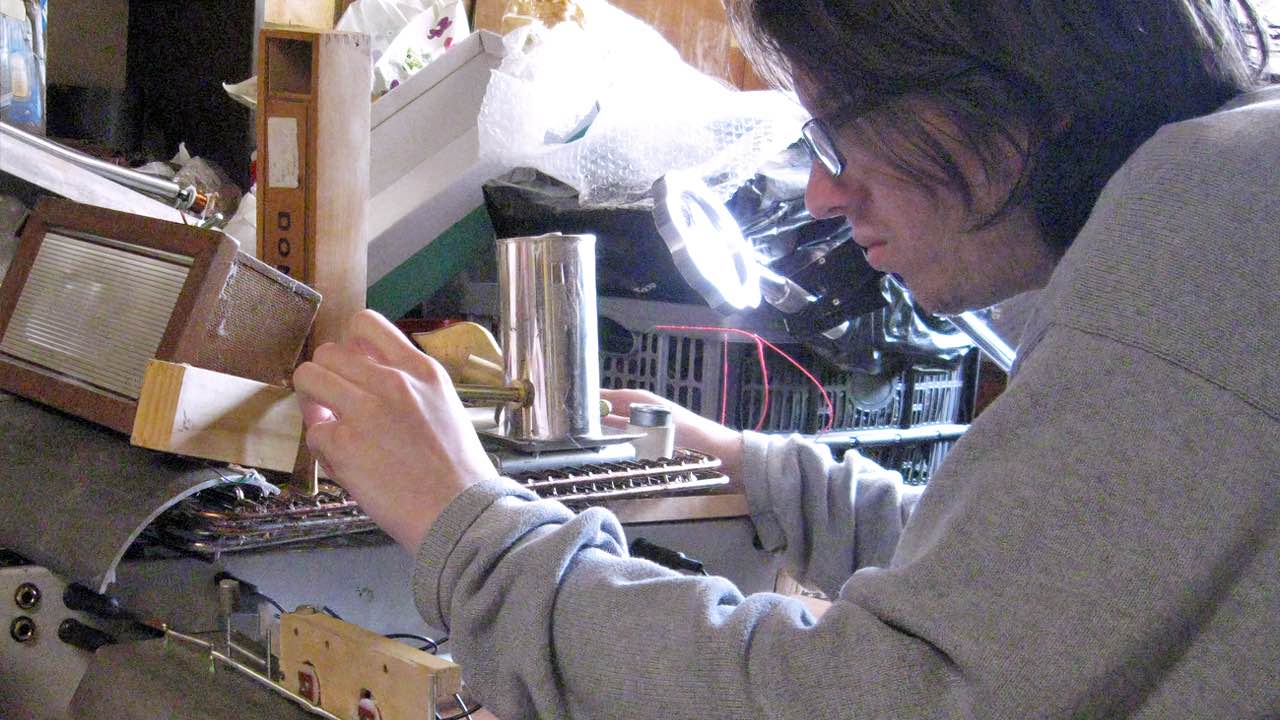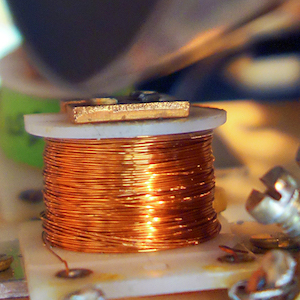Post-Electronic Sound Explorations
Post-electronic music philosophy and acoustic hacking has been an enduring interest of Oscillatorial Binnage member Daniel Wilson for two decades. At post-electronic workshops and lectures around the world, acoustic analogues of electronic processes were sought within the physical world, using solar-powered electromagnetic force fields to resonate found objects - the results consistently prove that bringing objects and apparatuses together to create a giant communal acoustic synthesisers can equal or surpass the varieties of sounds produced electronically.
 Post-electronic soundmaking is an ongoing pursuit of Oscillatorial Binnage member Daniel Wilson. Due to economic-necessity, with ecological concerns also in mind, recycled items found through dumpster-diving provide the raw materials for Wilson's post-electronic acoustic synthesisers. Since showcasing acoustic hacking experiments in his landmark Corrosion Suite (2007), it has become clear that acoustically coupling large scale apparatuses increases the variety of tones, yet this is not always possible without access to large spaces. This size issue is currently what holds back acoustic solutions from rivalling electronic soundmaking equivalents (i.e. portable synthesisers). This project, therefore, explores how post-electronic apparatuses can be made less unwieldy, and possibly miniaturised.
Post-electronic soundmaking is an ongoing pursuit of Oscillatorial Binnage member Daniel Wilson. Due to economic-necessity, with ecological concerns also in mind, recycled items found through dumpster-diving provide the raw materials for Wilson's post-electronic acoustic synthesisers. Since showcasing acoustic hacking experiments in his landmark Corrosion Suite (2007), it has become clear that acoustically coupling large scale apparatuses increases the variety of tones, yet this is not always possible without access to large spaces. This size issue is currently what holds back acoustic solutions from rivalling electronic soundmaking equivalents (i.e. portable synthesisers). This project, therefore, explores how post-electronic apparatuses can be made less unwieldy, and possibly miniaturised.
Side story Actively pursuing post-electronic acoustic solutions since 2004, Daniel Wilson's instruments have been featured in Channel 4's Ideas Factory, Nic Collins' Handmade Electronic Music textbooks, Electronic Sound, The Wire, and many other outlets. Wilson performs in electroacoustic quartet Oscillatorial Binnage. Running parallel to post-electronic modular acoustic instrument design is an ongoing research initiative. Post-electronic music necessarily draws upon the technologies of pre-electronic music, encompassing innovations of antiquity, such as Vitruvius' sound-reinforcing acoustic jars, to elaborate Victorian contraptions. Acoustical tone modification mechanisms outlined in 19th century musical patents show a clear pre/post-electronic kinship, for example, in an 1880 patent by Richard Howson, piano tone and volume were controlled via a hinged soundboard adjustably brought into contact with the stringed frame. Elsewhere, Adam Cyrus Engert's 1878 and 1880 patents proposed distributing sound via stretched, acoustically-coupled wires, connecting instruments with reverberant sheets of iron or wood held by springs for "refracting, reinforcing and modulating sound". An 1879 invention by Eugene Bornand described "Le Vibrateur" consisting of two loosely-clasped convex discs connected with a tube, which, when agitated with sound, and "by gentle pressure of the fingers on the convex surfaces, [causes] the evolution of modified sound, weird, grotesque, or euphonious". Similar methods to these have all been employed in post-electronic apparatuses where looseness and adjustable interconnectedness provide means of tone alteration, but through the lens of electronic music technique, these technologies acquire new usefulnesses.
Frequently Asked Questions
What inspired you to do this?
Circumstances. Poverty compels the curious ear to develop economical workarounds. But there are intriguing effects in post-electronic devices - the infinite world of the real offers complex and unpremeditated flourishes.
How long did it take to make it?
It's an ongoing practice.
How long have you been doing things like this?
Since childhood - plucking chopsticks clamped to desks to emulate electronic tones, etc.
How much did this cost to do?
Almost nothing, but I hope to get money one day.
Have you done other things like this?
Yes - everything orbits around this.
What did you wish you knew before you started this?
The limits of the human endurance.
Are there plans available to make this? Do you sell this?
Yes - workshops are given, syllabus notes are provided. Also the Oscillatorial Binnage CD 'Agitations: Post-Electronic Sound' contains a short monograph.
What’s next?
My book is scheduled for publication late 2021: 'Post-Electronics: The Design and Philosophy of Acoustic Modular Synthesisers, Sound Engines, Mechanical Sequencers and Tone Modifiers'.
Resoures?
Bins, second-hand bookshops, libraries and sundry shelters.
Post Electronics (Daniel R Wilson)
: Instrument builder, composer, sound designer, post-electronic music theorist

Post-electronic sound maker. Acoustic analogies for electronic processes. Electromagnetic force fields vibrating things. Thaumatacoustic rustlings. Records as Meadow House and Radionics Radio. 1/4 of the electroacoustic improv quartet Oscillatorial Binnage.
Connect with Post Electronics (Daniel R Wilson)
How I can help you:
Bespoke instruments for sale, group acoustic instrument-building workshops, lectures.
Bespoke instruments for sale, group acoustic instrument-building workshops, lectures.
How you can help me:
Purchase Oscillatorial Binnage's CD+monograph titled 'Agitations: Post-Electronic Sounds' (on Sub Rosa records). Also, the book 'Post-Electronics: The Design and Philosophy of Acoustic Modular Synthesisers, Sound Engines, Mechanical Sequencers and Tone Modifiers' will be available late 2021.
Purchase Oscillatorial Binnage's CD+monograph titled 'Agitations: Post-Electronic Sounds' (on Sub Rosa records). Also, the book 'Post-Electronics: The Design and Philosophy of Acoustic Modular Synthesisers, Sound Engines, Mechanical Sequencers and Tone Modifiers' will be available late 2021.